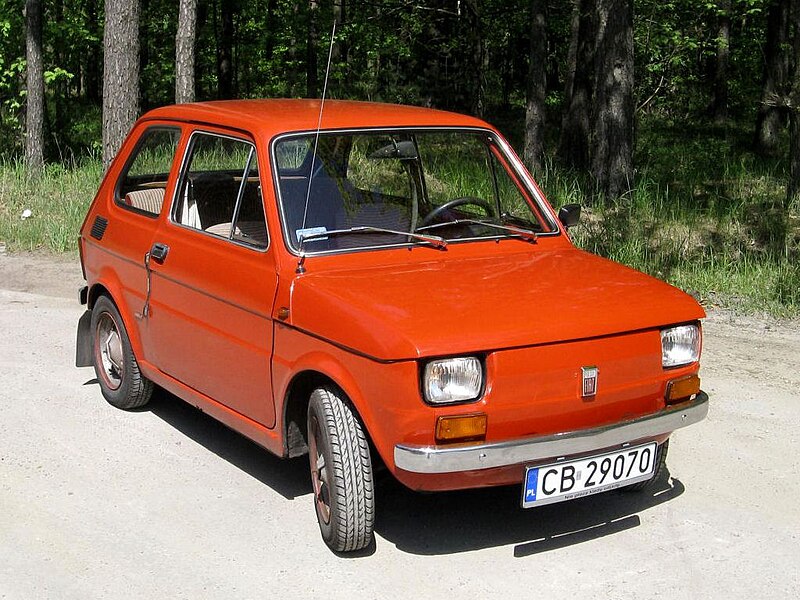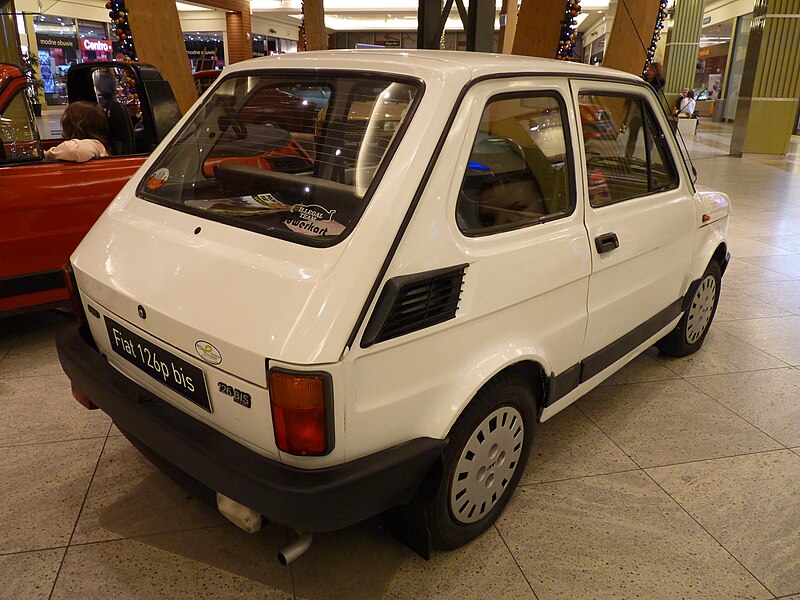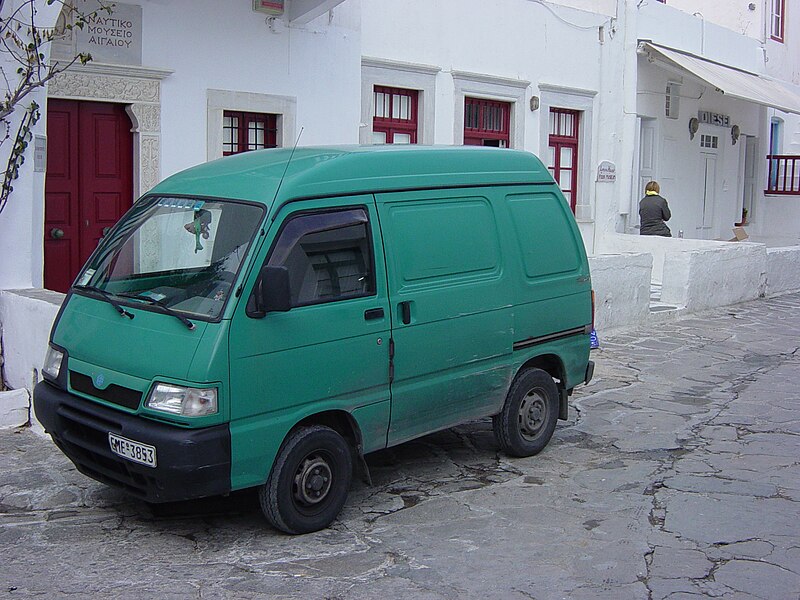Fiat 500
The Fiat 500 (Italian: Cinquecento, Italian pronunciation: [ˌtʃiŋkweˈtʃɛnto]) is a rear-engined, four seat, small city car that was manufactured and marketed by Fiat Automobiles from 1957 to 1975 over a single generation in two-door saloon and two-door station wagon bodystyles.
Launched as the Nuova (new) 500 in July 1957, as a successor to the 500 "Topolino", it was an inexpensive and practical little car. Measuring 2.97 metres (9 feet 9 inches) long, and originally powered by a 479 cc two-cylinder, air-cooled engine, the 500 was still 24.5 centimetres (9.6 inches) smaller than Fiat's 600, launched two years earlier, and is considered one of the first purpose designed city cars.
In 2007, the 50th anniversary of the Nuova 500's launch, Fiat launched another new 500, stylistically inspired by the 1957 Nuova 500, featuring a front-mounted engine and front-wheel drive.
In 2017 Fiat celebrated the 60th anniversary with an exhibit at the Museum of Modern Art in New York City and received one of the Corporate Art Awards by pptArt at an event hosted by the President of the Italian Republic Sergio Mattarella at the Quirinal Palace .
Nuova 500 (1957–1961)
Nuova 500 Sport (1958–1960)
500 D (1960–1965)
500 Giardiniera (1960–1975)
500 Furgoncino
500 F or Berlina (1965–1973)
500 L or Lusso (1967—71)
500 R or Rinnovata (1971—1986)
Fiat 126
The Fiat 126 (Type 126) is a rear-engined, small economy or city car, introduced in October 1972 at the Turin Auto Sho as a replacement for the Fiat 500. The majority of 126s were produced in Bielsko-Biała, Poland, as the Polski Fiat 126p, where production continued until year 2000. In many markets Fiat stopped sales of the 126 in 1993 in favour of their new front-engined Cinquecento. At a vehicle length of 3.05 metres, the Fiat 126 is almost exactly the same size as the original British Mini, and although it came to market 14 years later, production ended in the same year (2000), and its total sales of almost 4.7 million units were in close range of the Mini's 5.4 million. In Poland the car became a cultural icon and earned the nickname Maluch, meaning "The Little One" or "Toddler".
Polski Fiat 126p
Iso Isetta
The car originated with the Italian firm of Iso SpA. In the early 1950s the company was building refrigerators, motor scooters and small three-wheeled trucks. Iso's owner, Renzo Rivolta, decided he would like to build a small car for mass distribution. By 1952 the engineers Ermenegildo Preti and Pierluigi Raggi had designed a small car that used the motorcycle engine of the Iso Moto 200 and named it Isetta—an Italian diminutive meaning little ISO.
The Isetta caused a sensation when it was introduced to the motoring press in Turin in November 1953,[10] it was unlike anything seen before. Small (only 2.29 m (7.5 ft) long by 1.37 m (4.5 ft) wide) and egg-shaped, with bubble-type windows, the entire front end of the car hinged outwards to allow entry. In the event of a crash, the driver and passenger were to exit through the canvas sunroof. The steering wheel and instrument panel swung out with the single door, as this made access to the single bench seat simpler. The seat provided reasonable comfort for two occupants, and perhaps a small child. Behind the seat was a large parcel shelf with a spare wheel located below. A heater was optional, and ventilation was provided by opening the fabric sunroof.
Iso Autocarro
Lawil S.p.A.
The Lawil S.p.A. is a former Italian automobile manufacturer that began production in 1967. Lawil was located in Pavia, Lombardia. Lawil S.p.A. was a part of the French Lambretta and the Italian Innocenti.
Composition of the brand name: Henri Willame (Director of the French Lambretta) + Carlo Lavezzari (Designer) = LAvezzari + WILlame
Following models were available:
- Lawil Farmer (S1) 123cc (1968-1971, F) / Lawil Varzina (S3) 250cc (1970 - 1980, ITA)
- Lawil Farmer II 125cc (1975-1980, F)
- Lawil Berlina (S4) 250cc (ITA) / Willam City (A1 to A3) 123cc and 175cc (1967-1971, F) / Willam City (A4 and A5) 125cc (1971-1980, F)
- Lawil Pick-Up (C1) 123cc (until 1977, F)
- Lawil Fourgonnette (C2) 125cc (1968-1988, only saled in F)
- Lawil Break (C4) 125cc
Piaggio Porter
The Piaggio Porter is a licensed version manufactured in Italy since 1992 (originally as the "Innocenti Porter"), available also with diesel, LPG, CNG or electric motors. Originally equipped with a 1.0 petrol or a 1.2-litre diesel, more recent cars receive a 1,269 cc petrol/LPG engine or a 1,371 cc diesel. The 1.3 offers 65 PS (48 kW) in either configuration while the 1.4 diesel only manages 38 PS (28 kW). All of these Porter variants (S85) are based on the facelifted seventh generation of the Hijet (S82) which has its front wheel located below the front door and a mid-mounted engine.
Zagato Zele
The Zagato Zele 1000, 1500, 2000 (sold in the United States as the Elcar) was an electric microcar with a fiberglass body manufactured by the Italian design company Zagato. Produced 1974-1976, the Zele was an unusual departure from Zagato's famous designs, which had long been known for their beauty and performance. The Zele, however, was high, square cornered and had a low top speed. They were produced in 7 colors (Orange-red, Brown, Dark blue, Pastel blue, White, Green and metal flake Blue) and the chassis and suspension were derived from the Fiat 500 and Fiat 124. The 1000, 1500, and 2000 stands for the wattage of the motors respectively. Approximately 500 were made.




















.jfif)

No comments:
Post a Comment